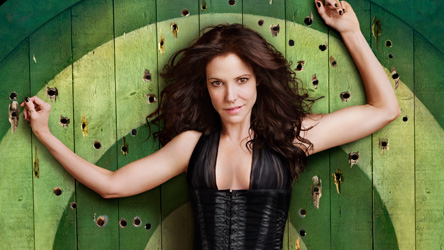Candy-Coated, Tangerine-Colored Criminals: Jenji Kohan’s Drug Use
Kathleen Collins / John Jay College

Seven years ago, viewers were introduced to Nancy Botwin, the white, middle class suburban widow who initially turned to pot dealing to maintain her family’s financial health (Weeds, Showtime, 2005-2012). This past summer, out came Piper Chapman, a white, middle class, urban, Smith graduate who, in her reckless twenties, transported drug money for her lover (Orange is the New Black, Netflix, 2013-).
The main differences between the two shows are that a) Piper (Taylor Schilling) is based on a real person, Piper Kerman, whose memoir Orange is the New Black (Spiegel & Grau, 2010) inspired the series, and b) Weeds takes place in various locations including the fictional Agrestic, CA, Tijuana and Copenhagen, and Orange takes place in a fictional New York State federal minimum security women’s prison. What these two crimestress-led1 series have in common, however, begins with their creator, Jenji Kohan. Just as Kohan has explained that the character of Piper was her Trojan horse to entice the suits to listen to her pitch as well as her gateway to get viewers to witness tales of underrepresented women (“You’re not going to go into a network and sell a show on really fascinating tales of black women and Latino women and old women and criminals,” she told Fresh Air’s Terry Gross2 ), so she uses the theme of crime to lure viewers into her shows, which are not primarily about crime. Criminals, yes, but criminals as they happen to be people who committed crimes, and in fact people who are not even that committed to those crimes.
Both Orange and Weeds are pleasurable indulgences. While we may get an inkling of what Piper Kerman’s prison stay was like – as well as Martha Stewart’s, especially when Piper fashions shower slippers and face masks from commissary maxi pads – they are far from realistic peep holes into the harsh and gritty drug and prison culture as were The Wire, Oz or even other women’s prison shows – Within These Walls, Prisoner Cell Block H and Bad Girls. Because they are essentially comedies, we can and should embrace Kohan’s playfulness and ought not to complain that most everybody looks well-groomed if not downright attractive and produces snappy dialogue as a matter of course.
Kohan gets away with this light touch because her protagonists are at a considerable remove from the actual world of drugs. While Nancy Botwin (Mary-Louise Parker) certainly gets entangled in myriad dangerous situations, she shimmies out basically unscathed (some scratches and bruises and a three-year prison sentence in between seasons notwithstanding), and she ends up rich thanks to the future legalization of her commodity of choice.

Decidedly soft on crime, (Kohan’s shows are virtually free of knives plunging into chests and do not engender in viewers that mostly irrational fear of the high likelihood of becoming a crime victim that other TV crime shows do), the viewer is at a safe remove, too, because, due to the shows’ presumed demographic, she or he is not likely to dabble in drug trafficking. As Slate’s June Thomas writes of Piper Chapman, “She’s an NPR-listening, Mad Men-watching, big-city-dwelling, wise-cracking intellectual. She’s just like ‘us,’ in other words. And none of ‘us’ would ever expect to go to prison.”3 We have the luxury of pushing the real drug culture to the edge of our consciousness. Kohan facilitates this expertly, focusing on the other elements of the shows. Piper’s crime is almost irrelevant; she might just as well have stolen jewels or committed fraud. Nancy’s product being pot, as opposed to cocaine, meth or heroin, also puts a more velvety veneer on her dealings (despite the fact that in the U.S., the criminalization of petty drug use has negatively impacted U.S. society in untold number of ways).4
If not about crime and drugs, then what are Weeds and Orange about? They contend with the same fodder that many non-crime shows do. Kohan takes some of the theatrical elements of the TV crime and prison dramas that titillate us (see previously mentioned programs as a small sample) and mixes in sassy comedy repartee and a dash of sentimentality. They comment on suburbia, middle class consumerism and shallow, first world concerns. There is no axe grinding about drug wars or laws or epidemics. They are highly palatable crime-adjacent stories that grapple with morality, loyalty, pride, sex and other relatable human soft spots. Broadly viewed, Weeds is a racier Parenthood and Orange is not all that different from Girls or Sex in the City but with more diverse characters and fewer fashion choices to ogle.

Subject to the ever-increasing edginess bar of “quality TV,” drugs were Kohan’s admission ticket. Nancy Botwin and Piper Chapman are not hard criminals, like Tony Soprano, Walter White or Omar Little. These women perpetrated their crimes out of stereotypically female motives – maternal obligation and passion respectively, proverbial crimes of the heart. But protagonist criminals – antiheroes – are almost a sure thing these days to become a pillar of this third golden age of TV in which we are reportedly immersed, alluring to media executives and viewers alike.5 Weeds without weed is a show with probably a less sexy title about a suburban mom struggling to raise her sons. With that special magic hook, however, a whole new market is tapped – the prized younger and male one.
Kohan’s Botwin and Chapman are soft-pedaled into the criminal protagonist genre. The shows are comedy-dramas, and the crimes involved are basically bloodless, non-violent transgressions. A majority of viewers may not be ready to see a woman murderer headlining a TV show just as we may not be ready, as Kohan admits, to headline one with a black, Latina or old criminal. We (well, not us) may not even be all that comfortable with women criminals (or black, Latino or old protagonists) of any stripe. Kohan worked with the system to both get the show on the air – use middle class white decoy with provocative crime backdrop – to tell stories of women of color and also human stories in general. As she says, “She’s just a great entry point for a lot of people.”6
In contrast, in Dexter and Breaking Bad, crime shows where the protagonist at least initially perpetrates crime for a supposedly noble sake, the criminal act is central to each episode’s arc, and the interpersonal plot lines are slightly off to the side (or at least are not the reason we jones for the next episode). A more effective foil for Piper and Nancy – and not just based on gender – is Jackie Peyton. Nurse Jackie’s (Showtime, 2009-) protagonist antihero (Edie Falco) projects the show into the category of golden age quality TV, too, but Jackie’s situation is different from Piper’s and Nancy’s in one crucial way – she is an addict. Consequently, Nurse Jackie is about drugs. It (the topic of drugs) is far more essential to the plot than it is in Weeds or Orange with storylines that focus on Jackie’s accessing (stealing) them and lying about her use. Though still a dramedy – punctuated with requisite snappy dialogue and pretty characters – it leans heavily toward drama. Liz Brixius, Linda Wallem and Evan Dunsky’s Nurse Jackie is black licorice to Kohan’s M&Ms, a bit more challenging if not sophisticated.

Nurse Jackie is emotionally wrenching as it involves watching a competent and likable woman who, at the bottommost times like many addicts, puts her substance ahead of her family, friends, career and health. For a woman and mother to do so is sinister but real. As a result, it is darker, more forthright and more heartfelt than Weeds or Orange. Nurse Jackie resists the saturated candy coating enjoyed by Weeds and Orange because addiction is something that likely does touch the lives of many viewers. Jackie is more in danger of being judged by viewers (for a variety of complicated reasons) than Nancy or Piper who are not engaged directly with the drugs they move(d) around. Paradoxically, they come off as clean, thereby further abating their criminality and distastefulness potential and opening the door for levity.
The crux of Piper and Nancy’s stories seems to be that middle class white women aren’t real criminals and will land on their feet. Serious crimes though they do engage in, Nancy and Piper are seen as peripheral to the drug industrial complex. To quell any potential objections, they pay in an evident way for their crimes with short prison sentences. It all worked out for Nancy, even if her personal life exists in small ragged piles around her. As of this writing, Piper is still paying for her sins with her 15-month sentence that she only loosely takes responsibility for in the first place. Though also a middle class white woman, Jackie does not get off so easily. Thus far, her penance has been meted out with karmic rather than legal interference. She has damaged her closest relationships and succumbed briefly and unsuccessfully to rehab. She struggles mightily with her addiction, the pain apparent in each episode. One could assemble these conclusions and suspect that drug war generals Nixon and Reagan engineered the message: the fundamental culprit is the morally bereft user.
But let’s remove poor Jackie from our minds for now and return to our diversion. While Kohan does not insistently push any envelopes – even in a potential attempt to level the gender balance in the TV antihero playing field – the drug crime themes provide a colorful and multi-use backdrop for her storytelling, which is smart, edgy, funny and well delivered. It’s entertainment, not social change, and we are all entitled to treats.
Image Credits:
1. Mary-Louise Parker as Nancy Botwin on Weeds
2. Taylor Schilling as Piper Chapman on Orange is the New Black
3. Breaking Bad’s Walter White (Bryan Cranston)
4. Edie Falco as Nurse Jackie
Please feel free to comment.
- According to Philip C. Kolin in American Speech, 60.1, (1985), p. 61, the term crimestress was coined in a 1982 TV Guide description of The Bonnie Parker Story. [↩]
- Fresh Air, August 13, 2013 [↩]
- Slate, July 12, 2013 [↩]
- Excellent sources for more on this topic: Eugene Jarecki’s documentary The House I Live In and Michelle Alexander’s book, The New Jim Crow: Mass Incarceration in the Age of Colorblindness [↩]
- In his recent book, Difficult Men: Behind the Scenes of a Creative Revolution, From The Sopranos and The Wire to Mad Men and Breaking Bad, Brett Martin parses the three golden ages of television as well as male TV criminals. [↩]
- IndieWire, July 8, 2013 [↩]